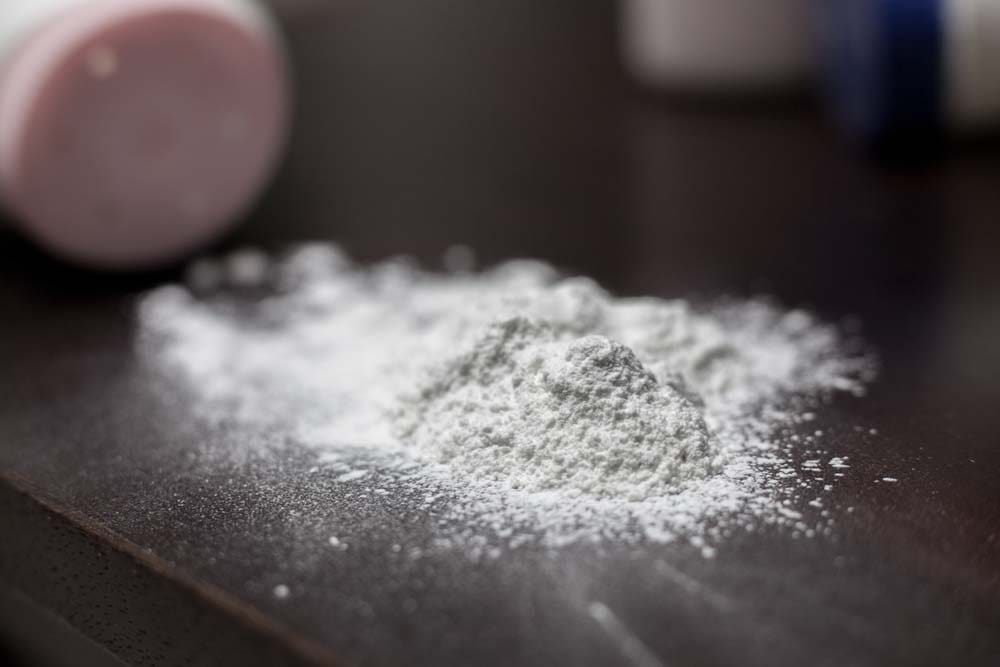Although controversial, talcum powder remains a common ingredient in many commercial and household products. And while its safety has been a subject of several studies and ongoing litigations for many years now, talcum powder continues to be a vital component in many industries and serves various purposes and applications.
With the talcum powder lawsuits still in progress and their end nowhere in sight, the litigation has highlighted plenty of concerns about talcum powder’s link to different types of cancer, the most common of which is ovarian cancer and mesothelioma.
Discovery of Talcum Powder
Johnson and Johnson launched their popular and iconic talc-based baby powder in 1894. Still, the history of talcum powder truly began when it was first found on a farm in Madoc in Ontario, Canada, during the 1880s.
It was not until the 1890s that talcum powder was commercially mined and produced during the widespread mining operations in the Canadian talc mines. One of the first large-scale talc mining operators was Henderson Talc Mine which began production in 1896, and Conley Mine, which opened near Henderson in 1911.
Over the years, these two prominent mining operators changed leadership multiple times. In 1937, they finally merged, and the new company was renamed Canadian Talc Limited. Fourteen years later, in 1951, Canadian Talc Mine was bought by Canada Talc Industries Limited.
More than 800,000 tons of high-quality talcum powder have been mined from the Canadian talc mines. Before ceasing mining operations in 2010, the Canadian Talc Mine was the oldest and longest-running talcum powder mine in Ontario.
As of 2018, the countries that mine and produce talc the most are China, India, Brazil, South Korea, France, Japan, Finland, and the United States. Most talc deposits can be found in the eastern Appalachian and Piedmont regions from New England to Alabama in the US. Other talc mines with many talc deposits are located in California, Montana, Nevada, Texas, and Washington.
Etymology
According to the website of the University of Waterloo Earth Sciences Museum, talc is derived from the Medieval Latin word “talcum” and the Arabic word “tolk“, which means “mica.” Therefore, it seemed appropriate that the softest mineral in the world will be named as such because talc is said to produce “mica-like flames.”
Another name for talc is kerite, but it is not so commonly used as the present name, which Georgius Agricola gave in 1564.
Five Main Properties of Talcum Powder
Talcum powder is a widely used mineral in many industrial and domestic settings, and what makes them highly functional in many industries is the presence of these properties:
- Familiarity (composed of platelets that slide off each other)
- Softness (unctuous and nonabrasive)
- Chemical inertness
- Affinity for organic chemicals
- Whiteness
Because of these properties, talcum powder makes for an effective adsorbent, lubricant, anti-sticking agent, anti-caking agent, thickener, smooth filler, and strengthening filler.
The Uses of Talcum
Talcum powder can be used in a lot of ways, but it is most commonly used in the following:
Cosmetics
Talc is typically the main ingredient in many powder-based cosmetic products. Because of its softness, talc-containing powder products tend to be easier to apply and remove without irritating the skin.
Talc is also a common component in antiperspirant products because of its ability to absorb moisture, oils, and odor that produces an astringent effect once in contact with the skin.
Paint
Talc acts as an extender and filler in paint. Because of its broad shape, talc helps improve the suspension of mineral particles in the paint and allows it to adhere better to the wall to prevent sagging.
Plastics
Talc acts as a filler in manufacturing plastics, and increases the stiffness and heat resistance of vinyl, polyester, nylon, polyethylene, and polypropylene.
Ceramics
Just like its role in manufacturing plastics, talc also acts as a filler in the production of ceramic products like tiles, dinnerware, and pottery to improve the greenware and durability of the ceramics as they are bisque fired.
Paper
Talcum powder’s great adsorption qualities are vital in papermaking and producing paper products where talc is used to adsorb organic impurities, which are typically sticky. Talc also acts as a filler in paper which improves smoothness for better ink transfer when printing and reduces friction and abrasion so that the printed output has a more polished feel and finish.
Roofing
Talc in roofing materials improves durability and resistance, allowing roofs to withstand strong weather occurrences. Moreover, talc also makes installing asphalt shingles easier as it prevents them from sticking to each other.
Findings About Talcum Powder
Through the years, several studies have been conducted to establish the link between talc and ovarian cancer, the most common disease linked to talcum powder exposure. But while they all showed varying degrees of ovarian cancer risk, the studies say one thing: the popular Johnson & Johnson baby powder does increase the risk of ovarian cancer.
- Cancer Prevention Research Study (2013) – According to a study by this prominent cancer research journal, there is “an increased risk of ovarian cancer between 20 and 30 percent for women who used talcum powder for intimate personal hygiene.”
- The Cramer Study (2016) – Led by Harvard epidemiologist Dr. Daniel Cramer, the study found that “women who used talcum powder on their genitals and sanitary pads on a regular basis were at more than three times the risk” of developing ovarian cancer.
- The Schildkraut Study (2016) – In this study by Joellen M. Schildkraut that examined African American women, it found that those “who use talcum powder in their groin area have a 44% increased risk for ovarian cancer.”
- Tisch Cancer Institute of Mount Sinai Hospital (2017) – In this study, it was reported that although there is a weak link, there is a “statistically significant association between genital use of talc and ovarian cancer.”
- Ovarian Cancer Cohort Consortium (2020) – According to their analysis, the OC3 reported that “use of talcum powder on genitals is associated with a 24% increased risk of ovarian cancer.”
Health Risks Linked to Talcum Powder
Testicular cancer, lung cancer, uterine cancer, talcosis, pneumonia, and asthma are just some of the diseases linked to talcum baby powder exposure. But in the tens of thousands of talcum powder lawsuits that have been filed over the years, ovarian cancer and mesothelioma seem to be the most prevalent among the plaintiffs.
Ovarian Cancer
Ovarian cancer is an often fatal cancer type that can develop in the female reproductive system. According to the Center for Disease Control and Prevention (CDC), ovarian cancer is a “group of diseases that originates in the ovaries, or in the related areas of the fallopian tubes and the peritoneum.”
In many talcum baby powder lawsuits, the female plaintiffs claimed that they developed ovarian cancer due to talcum powder exposure. Most female plaintiffs have been using J&J’s baby powder for years — either for their babies or in their genital areas — and they believe their continued use of J&J’s talcum powder products led them to be diagnosed with ovarian cancer.
Mesothelioma
According to The Mesothelioma Center, mesothelioma is a “malignant tumor that is caused by inhaled asbestos fibers and forms in the lining of the lungs, abdomen, or heart.” For people diagnosed with this deadly illness, life expectancy is about 12 months at most after diagnosis.
Because mesothelioma is mainly caused by asbestos, it became another common illness linked to the long-term use of J&J baby powder, which was alleged to contain dangerous amounts of asbestos.
But mesothelioma does not develop overnight. According to Drugwatch, mesothelioma is usually diagnosed 20-50 years after exposure to asbestos-contaminated talc. And because symptoms do not show straight away, it can be difficult to diagnose until it is already too late.
The Link Between Asbestos & Talc
According to the National Cancer Institute, asbestos has been confirmed as a human carcinogen by the US Department of Health and Human Services, the US Environmental Protection Agency, and the International Agency for Research on Cancer — the World Health Organization’s cancer research arm.
J&J is known to take great pride in the “high purity” of the cosmetic talc they use in their baby powder. However, in its purest form, talcum powder usually contains asbestos.
Moreover, asbestos-like talcum powder — is also a naturally occurring mineral. And because these two minerals are typically found near each other in many talc mining sites, it makes talcum powder highly susceptible to asbestos contamination.
The Talcum Powder Lawsuits Through the Years
Judith Winkel v. Colgate-Palmolive (May 2015) – Winkel claimed that Colgate-Palmolive’s Cashmere Bouquet talcum powder caused her mesothelioma after using the product from 1961 until 1976. The jury awarded her $13 million, but before they could decide on the amount of additional punitive damages, her case had already been settled for an undisclosed amount.
Jacqueline Fox v. Johnson & Johnson (February 2016) – Fox was the first-ever female complainant to achieve a favorable ovarian cancer verdict against J&J. After using J&J’s talcum products religiously for 35 years, Fox was eventually diagnosed with ovarian cancer and died in October 2015. Four months later, a St. Louis jury awarded her $72 million. But in October 2017, this decision was reversed by the Missouri Court of Appeals.
Deborah Giannecchini v. Johnson & Johnson (October 2016) – Giannecchini had been using the Johnson & Johnson talcum powder on her genitals for about 40 years. As a result, she developed ovarian cancer and was diagnosed in 2016 to have an 80% chance of dying in the next two years. Fortunately for Giannecchini, the jury ruled in favor of her and awarded her roughly $70 million and an additional $2 million paid by co defendant Imerys Talc America, one of J&J’s major talc suppliers.
Philip Depoian v. Whittaker, Clark & Daniels (October 2016) – Depoian used to frequent the barbershop his father worked at and claimed that his mesothelioma diagnosis resulted from inhaling talc particles and asbestos exposure from talcum powders in his father’s workplace. A Los Angeles jury eventually ruled in favor of him and awarded him $18 million to be paid by talc supplier Whittaker, Clark & Daniels.
Lois Slemp v. Johnson & Johnson (May 2017) – Slemp alleged that her ovarian cancer was caused by J&J’s talcum powder products that she had been using for over 40 years. A St. Louis jury awarded her a total of $110 million in compensatory and punitive damages, but the ruling was reversed in October 2019.
Eva Echeverria v. Johnson & Johnson (August 2017) – Echeverria claimed that her continued talcum powder use for over 40 years caused her to develop ovarian cancer. A California jury ruled in favor of her, and she was awarded $417 million, but she died shortly after, the following month after she won her case. In 2017, the verdict was overturned.
Richard Booker v. Imerys Talc America (December 2017) – Booker sued talc supplier Imerys alongside Dexter Midland Chemical Co., Walter N. Boysen Co., and Vanderbilt Minerals after he was diagnosed with mesothelioma as a result of his constant exposure to asbestos-contaminated talc found in the paint he was making when he was still working for Dexter Midland and Boysen. Booker died in 2016, but he was only awarded over $22 million in damages by a California jury about a year after his death.
Stephen Lanzo III v. Johnson & Johnson (April 2018) – Lanzo III sued J&J and its talc supplier Imerys after he developed mesothelioma from constant use of J&J’s baby powder and Shower to Shower for years. A New Jersey jury eventually awarded Lanzo III $117 million in damages, but this verdict was later overturned in April 2021 to rule in favor of J&J.
Missouri class action lawsuit (July 2018) – Twenty-two women were behind this landmark class-action lawsuit. All of them claimed that J&J’s asbestos-contaminated talcum baby powder had caused them to develop ovarian cancer. In total, a St. Louis jury awarded them a whopping $4.69 billion in damages. J&J appealed the ruling, but the decision was not reversed, and the initial verdict was upheld.
Douglas Barden et al. v. Johnson & Johnson (September 2019) – Plaintiffs Douglas Barden, Will Ronning, D’Angela Mcneill-George, and David Etheridge claimed that they got mesothelioma after they ingested asbestos and talc particles from using the Johnson & Johnson talcum powder. A New Jersey jury awarded them $37.2 million in compensatory damages and an additional $750 million in punitive damages.
Christina Prudencio v. Johnson & Johnson (August 2021) – Plaintiff claimed that her long-term J&J talcum powder use led to her mesothelioma diagnosis. She was eventually awarded by a California jury with $26.5 million and an additional $100,000 million in punitive damages.
How the Talcum Powder Lawsuits are Being Dealt With
In a May 2020 announcement, J&J said that they remain “steadfastly confident in the safety of talc based Johnson’s Baby Powder” and that the safety of their most popular product is backed by “decades of scientific studies by medical experts around the world.”
J&J also added that they “will continue to vigorously defend the product, its safety, and the unfounded allegations against it and the company in the courtroom.”
J&J Baby Powder Voluntary Recall
In October 2019, J&J announced that they would recall 33,000 bottles of their baby powder distributed in North America after the FDA found traces of asbestos in samples taken from a single bottle included in that batch.
LTL Management’s Bankruptcy Filing
Two years later, J&J established LTL Management as their subsidiary in a move that many saw as a desperate and offensive attempt to evade accountability and dodge the mounting legal costs.
In a press release, J&J said they created LTL Management “to hold and manage claims in the cosmetic talc litigation.” As for LTL’S bankruptcy protection filing, J&J said it is “intended to resolve all claims related to cosmetic talc in a manner that is equitable to all parties, including any current and future claimants.”
With a new subsidiary, J&J split its assets from its liabilities. And with bankruptcy protection in place and bankruptcy proceedings expected in the following months, this means that all the ongoing talcum powder lawsuits against J&J need to be temporarily stopped while LTL awaits its bankruptcy decision.
Many cancer plaintiffs consider J&J’s controversial legal move, now infamously called the Texas Two-Step, as an attempt to delay and prevent their cases from ever going to trial. In a recently published special report, Reuters revealed that the creation of LTL and its immediate bankruptcy filing are all part of J&J’s secret plan — dubbed as Project Plato — to “redirect cancer plaintiffs out of trial and into bankruptcy process.”
In J&J’s defense, LTL Management President Robert Wuesthoff said in the jury trials that “most of the cancer plaintiffs would be better off resolving their claims in a bankruptcy settlement than hoping to join the ‘select few’ who won ‘lottery-sized awards.’
Key Takeaways
Much of the focus has been on the use of talc in Johnson & Johnson’s baby powder, but the uses of talcum powder go beyond the cosmetics industry. Learning about its beginnings will provide a more educated perspective on this highly contentious mineral to understand talcum powder better.
One can never be too careful, especially when it comes to health and safety, so for now, the best course of action is to educate ourselves about talcum powder and the health risks associated with it and stay up-to-date with the ongoing talcum powder lawsuits to have an idea of how you can deal with such cases should the need to seek legal action ever arise.




